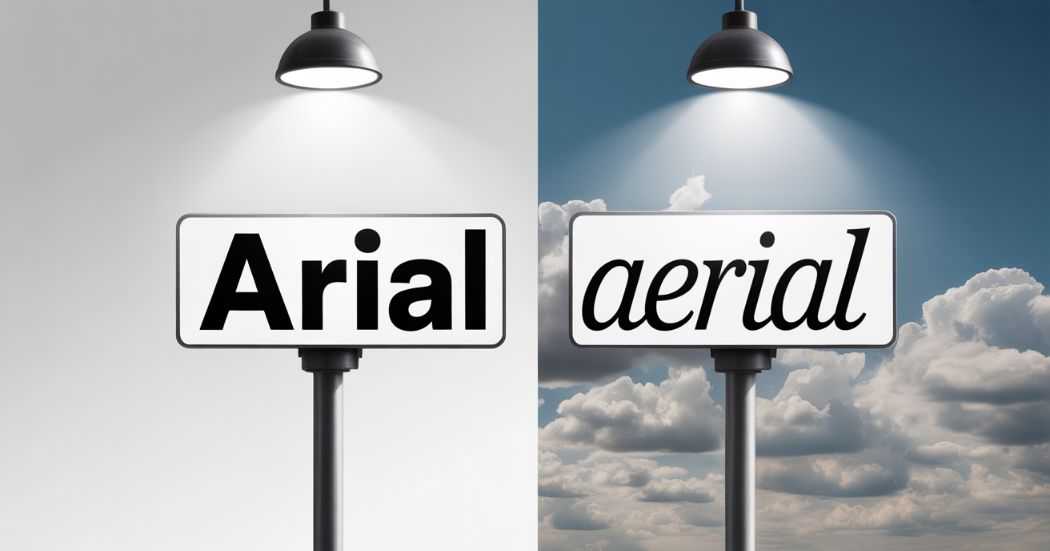Language is full of homophones and near-homophones words that sound alike but have different meanings and spellings. One common mix-up that causes confusion in writing and speech is the pair: “Arial” and “Aerial.” Despite their similar pronunciation, these two words are vastly different in meaning and usage. Understanding the difference can help you avoid awkward errors, especially in professional or academic settings.
Let’s dive into what each word means, explore real-life scenarios where one is used correctly over the other, and give you some helpful tips to remember the distinction.
What Does “Arial” Mean?
“Arial” is most commonly recognized as the name of a font type—a sans-serif typeface that is widely used in digital and print media.
Examples of Arial in Use:
- “Please submit your report using Arial, size 12, and double-spaced formatting.”
- “The presentation looked cleaner once the text was changed to Arial instead of a fancy script font.”
Important Notes:
- Arial is always a proper noun when referring to the font, so it should be capitalized.
- It is not used as a descriptive adjective in general contexts—it’s almost exclusively tied to typography.
What Does “Aerial” Mean?
On the other hand, “Aerial” is an adjective or noun related to air, the atmosphere, or things that happen above the ground. It’s derived from the word aer, the Latin and Greek root meaning “air.”
“Aerial” as an Adjective:
It describes anything that takes place in or from the air.
- “The photographer captured stunning aerial views of the city from a drone.”
- “A group of acrobats performed an aerial routine that left the audience breathless.”
“Aerial” as a Noun:
It can also be a noun, particularly in British English, referring to an antenna used to receive television or radio signals.
- “Make sure the aerial on the roof is pointing in the right direction for a better signal.”
Common Scenarios Where People Confuse “Arial” and “Aerial”
Let’s look at some specific examples that illustrate the confusion—and clarify which word is correct.
✅ Correct: “Arial”
- “Please change the heading to Arial font.”
- Why it works: The sentence is clearly talking about a typeface.
❌ Incorrect: “Aerial”
- “Please change the heading to Aerial font.”
- Why it’s wrong: The speaker meant the font Arial, but used Aerial, which refers to something related to air.
✅ Correct: “Aerial”
- “The documentary includes aerial footage of the Amazon rainforest.”
- Why it works: The footage was captured from the air, possibly using drones or helicopters.
❌ Incorrect: “Arial”
- “The documentary includes Arial footage of the Amazon rainforest.”
- Why it’s wrong: The sentence mistakenly uses the font name Arial, which makes no sense in this context.
How to Remember the Difference
Sometimes all it takes is a simple mental trick to keep things straight. Here are a few tips:
Tip #1: Think “Air” in “Aerial”
The word “Aerial” has the word “air” tucked inside it. If the subject relates to air, flying, views from above, or antennas, it’s likely you want aerial.
- “Aerial acrobat” = Acrobat in the air
- “Aerial view” = View from the air
- “Aerial antenna” = Used to catch signals in the air
Tip #2: Think “Arial” = Font
Think of Arial as a neutral, no-frills font—it’s the standard in many documents.
- You don’t “fly” in Arial. You type in it.
- It’s often the default font in Microsoft Word.
Tip #3: Visual Association
If you’re a visual learner, associate “Arial” with a document or typeface setting. Think of seeing “Arial 12 pt” in a font menu. Associate “Aerial” with sky imagery: drones, airplanes, or birds.
Tricky Examples and Edge Cases
Scenario 1: The Advertising Misstep
- A design agency wrote: “We specialize in Arial photography.”
- What they meant: “We specialize in aerial photography.”
- The error made their service sound like they took pictures of font styles instead of landscapes from above.
Scenario 2: Student Assignment Confusion
- A student wrote: “My teacher asked us to use aerial for our essay format.”
- This could lead to confusion unless the teacher has an interest in aviation. It should be: “My teacher asked us to use Arial for our essay format.”
When Autocorrect Doesn’t Help
One of the reasons this confusion persists is because both “Arial” and “Aerial” are valid words—so autocorrect won’t always catch the mistake. It’s up to the writer’s awareness to choose the right one.
Example:
- Typing “Arial footage” may not be flagged by your word processor, but it’s contextually incorrect.
When You Might Use Both (But Carefully)
There are very few situations where both words might appear in the same context, but here’s one just for fun:
- “We overlaid the Arial text on the aerial photograph of the city.”
In this case:
- Arial = the font used for the text
- Aerial = the photo taken from above
This sentence is grammatically correct and uses both words properly—but such examples are rare and specific.
Summary: Arial vs. Aerial
Here’s a quick recap to help solidify your understanding:
| Word | Part of Speech | Meaning | Common Context |
|---|---|---|---|
| Arial | Noun (proper) | A typeface/font | Typography, documents |
| Aerial | Adjective/Noun | Related to air or sky | Photography, acrobatics, antennas |
Final Thoughts
Mistaking “Arial” for “Aerial” might seem minor, but it can cause confusion and make your writing look careless. Especially in professional or creative settings, using the correct term shows that you pay attention to detail and have a clear grasp of language.
So next time you find yourself wondering whether to use Arial or Aerial, just ask: Am I talking about something in the air, or something in a document?


